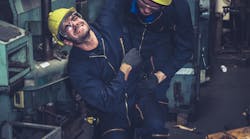On November 8, the U.S. Bureau of Labor Statistics said that private industry employers reported 2.8 million nonfatal workplace injuries and illnesses in 2022, up 7.5% from 2021.
This increase is driven by the rise in both injuries, up 4.5% to 2.3 million cases, and illnesses up 26.1% to 460,700 cases.
The main component of illnesses come from respiratory illness cases, up 35.4% to 365,000 cases in 2022.. This comes after a decrease in respiratory illnesses in 2021 compared to 2020.
Regarding statistics for 2022, the total recordable cases (TRC) incidence rate in private industry in 2022 was 2.7 cases per 100 FTE workers. In 2022, the rate of injury cases was 2.3 cases per 100 FTE workers, unchanged from 2021.
The illness rate increased in 2022, with private industry employers reporting a rate of 45.2 cases per 10,000 FTE workers compared to 37.7 cases in 2021. The increase was driven by a rise in the respiratory illness rate, which rose from 27.8 cases per 10,000 FTE workers in 2021 to 35.8 cases in 2022.
Looking at specific industries, transportation and material moving occupations experienced the highest number of DART cases among major occupation groups with 835,040 total injuries and illnesses over the 2021-2022 period. These cases occurred at an annualized incidence rate of 410.0 cases per 10,000 FTE. Among these total DART cases, 503,610 cases (60.3%) required at least one day away from work, and 331,430 cases (39.7%) resulted in one or more days of job transfer or restriction.
Do the Numbers Tell the Full Story?
According to a statement from the National COSH, “the BLS survey, which includes serious injuries and illnesses that require medical treatment beyond first aid, is based on self-reports from employers. The U.S. Congress, the Government Accountability Office and academic experts all agree that BLS significantly underestimates the real toll of pain and suffering.
“The GAO, for example, found that fewer than half of employers fully report injuries and illnesses as required by federal law. Firms also use subtle and not-so-subtle “incentives'' to discourage workers from reporting. Rather than encourage safe work practices, this creates pressure for workers to hide health problems they may be having on the job.”
The group also says that there is not sufficient data to analyze non-fatal injuries by race or ethnic origin. “Due to a long history of workplace discrimination, and evidence that Black and Brown workers are more likely to suffer fatal workplace injuries than other workers, it's important to investigate further and address racial disparities that impact workplace safety.”
Injuries Can Be Avoided
“We are allowing workers to get hurt or sick from hazards that can be avoided,” said Peter Dooley, a technical support specialist at National COSH, said in a statement.
The group says that companies need to provide effective worker training programs and “put a priority on eliminating hazards with system-wide engineering and operational changes, such as removing a toxic substance from the workplace. System-wide actions should take place before actions focused on individuals, such as providing personal protective equipment (PPE). This still exposes the worker to hazards and can provide a false sense of security.
A National COSH guide to “Building Worker Power Through Health and Safety Committees” recommends several steps to reduce preventable injuries and illnesses.
- Gathering input about safety problems directly from workers, using tools such as worker surveys, hazard mapping, and body mapping.
- Documenting and tracking health and safety problems as they arise.
- Investigating and addressing all health and safety issues in the workplace, including “close calls” to identify all the possible contributing factors that can be changed to correct the hazard.
- Training and education programs for workers in a language they understand and support for workers to understand their work environment and prevent hazard exposure.
- Closing the loop with workers to show what is being done to try and get better health and safety improvements on the job.
“We have the tools and technology to make our jobs safer,” said Dooley. “The challenge is to build worker power so we can implement these tools in all our workplaces.”
For more information, visit the Injured at Work Justice Campaign page at NationalCOSH.org.

